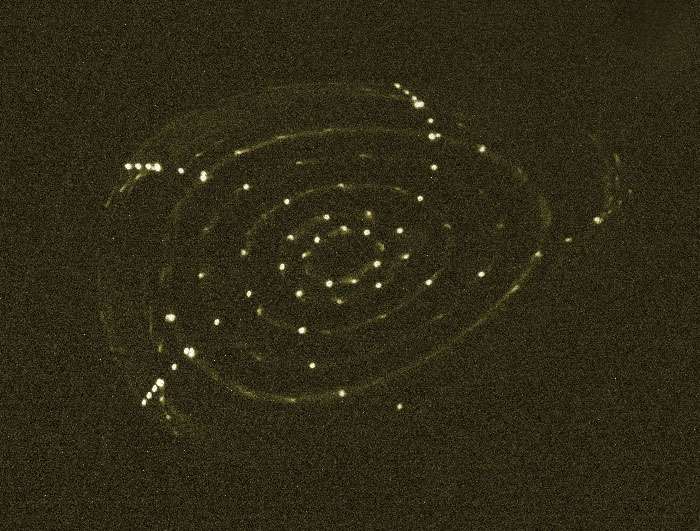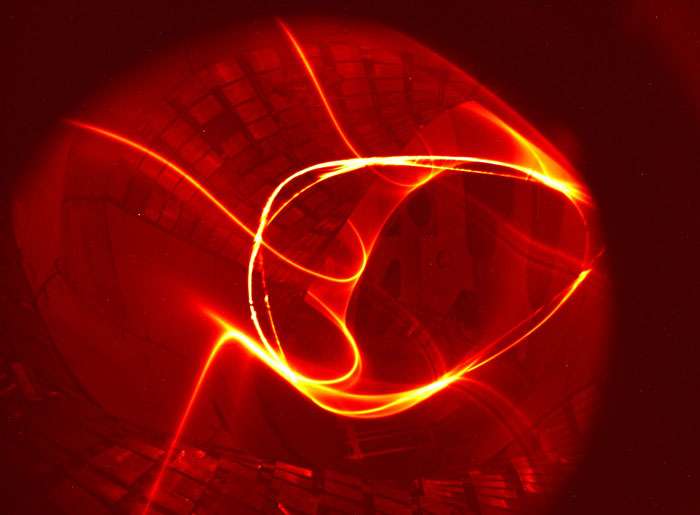Initial testing of the Wendelstein 7-X magnetic field

Testing of the magnetic field in the Wendelstein 7-X fusion device was completed sooner than planned. The measurements, which were much anticipated at the Max Planck Institute for Plasma Physics in Greifswald, show: The superconducting magnetic coils, whose technical tests were completed only last week are producing the required magnetic field. The magnetic cage for the fusion plasma, which has a temperature of many million degrees, has a configuration which is in line with the calculations of the physicists. This is an essential milestone in the operational preparations that are currently under way. Later this year, Wendelstein 7-X should produce its first plasma.
Although Wendelstein 7-X is not yet in operation, the experiment is already providing the first scientific results: the magnetic field meets the precise requirements for the confinement of the high- temperature fusion plasma. This is demonstrated by the first measurements of the field structure: "We've got nice closed flux surfaces", Prof. Dr. Thomas Sunn Pedersen, the IPP Division Head responsible for this task was pleased to announce.
How do you build a magnetic cage for the plasma? The fusion researchers make use of the fact that the charged plasma particles – ions and electrons – are kept on narrow spiral tracks around magnetic field lines by electromagnetic forces. As a result of a suitably formed field, the fast particles – as if guided on tracks – are kept away from the walls of the plasma vessel. To achieve a closed cage, the field lines in the centre of the circular plasma vessel must span closed, nested circular surfaces – like the growth rings inside a tree trunk. This prevents field lines pointing outwards, which would direct the plasma particles against the walls and make it impossible to achieve the high plasma temperatures required.

"Once the flux surface diagnostics were placed in operation, we were immediately able to see the first magnetic surfaces," reports Dr. Matthias Otte, who is responsible for the measurement process: "Our images clearly show how magnetic field lines create closed surfaces in many toroidal circulations". The flux surface diagnostics enables the structure of the field to be precisely measured. For this purpose, a thin electron beam is injected and moves along a field line in circular tracks through the evacuated plasma vessel. It leaves behind a tracer, which is created by collision of the electrons with residual gas in the vessel. If, in addition, a fluorescent rod is moved through the vessel cross section, light spots are created when the electron beam hits the rod. In the camera recording, the entire cross section of the magnetic field gradually becomes visible.
During a single measurement that lasts around 60 seconds, the electron beam circulates many times on "its" field line in the circular plasma vessel and thereby covers a distance of several kilometres. The spiral field line guides it after each circulation slightly offset through the plane through which the rod is moved. The image of the field cross section gradually forms from the light points on the rod. And indeed: in dotted lines the required nested flux surfaces are shown. "Following the lengthy assembly time, we are now very pleased with the excellent measurement results", says Professor Sunn Petersen: "The flux surfaces look just how we wanted them to appear."
Background
The objective of fusion research is to develop a power source that is friendly to the climate and the environment. Similarly to the sun, it harvests energy from the fusion of atomic nuclei. To light the fusion fire in a future power station, the fuel – a hydrogen plasma – must be confined in magnetic fields and heated to a temperature of over 100 million degrees. Upon its completion the Wendelstein 7-X , which will be the largest stellarator-type fusion device in the world, will not produce energy but will enable the suitability of this type of device as a power station to be investigated. With plasma discharges lasting up to 30 minutes, it should demonstrate its significant property – its ability to operate continuously.
A ring of 50 superconducting magnetic coils approximately 3.5 metres in height, is the key component of the device. Cooled with liquid helium to the superconducting temperature which is near to absolute zero, once switched on, they consume very little energy. Their special shapes are the result of refined optimisation calculations. Their task is to create a magnetic cage for the plasma with particularly good thermal-insulation properties.
In May 2014 the assembly of Wendelstein 7-X was completed on time and for over a year the preparations for operation have been under way. One by one, the operation of each technical system is being tested. From the end of April to the beginning of July 2015, attention was turned to the magnetic coils. As soon as the functional capability of these central system components was confirmed, the testing of the magnetic surfaces was carried out. Configuration of the computer-supported data collection for the experimental operation is still to be carried out and in the periphery of the device the equipment for monitoring and heating the plasma requires completion. The objective: the Wendelstein 7-X should produce the first plasma this year.
Provided by Max Planck Society



















